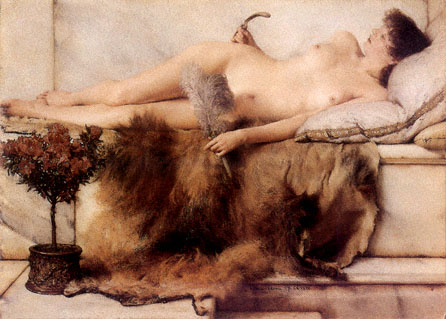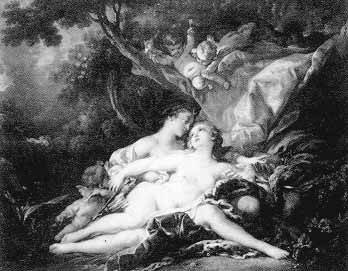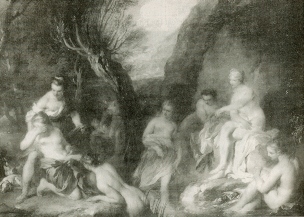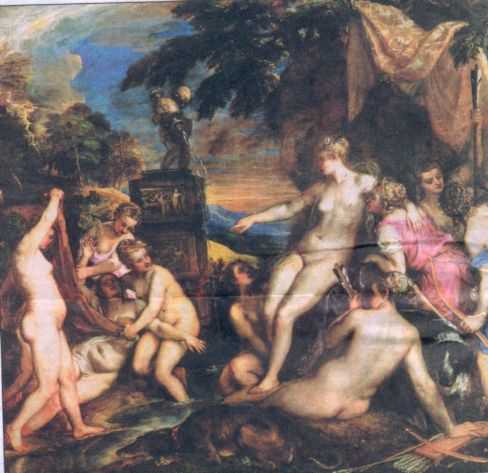Robert Graves' GREEK MYTHS
extract from introduction
 |
![]()
Excerpt from ROBERT GRAVES' GREEK MYTHS (Introduction) 1955
A study of Greek mythology should begin with a consideration of what political and religious systems existed in Europe before the arrival of Aryan invaders from the distant North and East. The whole of Neolithic Europe, to judge from surviving artefacts and myths, had a remarkably homogeneous system of religious ideas, based on worship of the many-titled Mother goddess, who was also known in Syria and Libya.
Ancient Europe had no gods. The Great Goddess was regarded as immortal, changeless, and omnipotent; and the concept of fatherhood had not been introduced into religious thought. She took lovers, but for pleasure, not to provide her children with a father. Men feared, adored, and obeyed the matriarch; the hearth which she tended in a cave or hut being their earliest social centre, and motherhood their prime mystery. Thus the first victim of a Greek public sacrifice was always offered to Hestia of the Hearth. The goddess' white aniconic image, perhaps her most widespread emblem, which appears at Delphi as the omphasos, or navel-boss, may originally have represented the raised white mound of tightly-packed ash, enclosing live charcoal, which is the easiest means of preserving fire without smoke. Later, it became pictorially identified with the lime-whitened mound under which the harvest corn-doll was hidden , to be removed sprouting in the spring; and with the mound of sea-shells, or quartz, or white marble, underneath which dead kings were buried. Not only the moon, but (to judge from Hemera of Greece and Grainne of Ireland) the sun, were the goddess' celestial symbols. In earlier Greek myth, however, the sun yields precedence to the moon - which inspires the greater superstitious fear, does not grow dimmer as the year wanes, and is credited with the power to grant or deny water to the fields.
The moon's three phases of new, full and old, recalled the matriarch's three phases of maiden, nymph (nubile woman) and crone. Them, since the sun's annual course similarly recalled the rise and decline of her physical powers - spring a maiden, summer a nymph, winter a crone - the goddess became identified with seasonal changes in animal and plant life; and thus with Mother Earth who, at the beginning of the vegetative year, produces only leaves and buds, then flowers and fruits, and at last ceases to bear. She could later be conceived as yet another triad: the maiden of the upper air, the nymph of the earth or sea, the crone of the Underworld - typified respectively by Selene, Aphrodite and Hecate. These mystical analogues fostered the sacredness of the number three, and the Moon-goddess became enlarged to nine when each of the three persons - maiden, nymph and crone - appeared in triad to demonstrate her divinity. Her devotees never quite forgot that there were not three goddesses, but one goddess; although by Classical times, Arcadian Stymphalus was one of the few remaining shrines where they all bore the same name: Hera.
Once the relevance of coition to child-bearing had been officially admitted - an account of this turning-point in religion appears in the Hittite myth of simple-minded Appu - man's religious status gradually improved, and winds or rivers were no longer given credit for impregnating women. The tribal nymph, it seems, chose an annual lover from her entourage of young men, a king to be sacrificed when the year ended; making him a symbol of fertility, rather than the object of her erotic pleasure. His sprinkled blood served to fructify trees, crops and flocks, and his flesh was torn and eaten raw by the queen's fellow nymphs - priestesses wearing masks of bitches, mares and sows. Next, in amendment to this practice, the king died as soon as the power of the sun, with which he was identified, began to decline in the summer; and another young man, his twin, or supposed twin - a convenient ancient Irish term is 'tanist' - then became the queen's lover, to be duly sacrificed at midwinter and, as a reward, reincarnated in an oracular serpent. These consorts acquired executive power only when permitted to deputise for the queen by wearing her magic robes. Thus kingship developed, and though the sun became a symbol of male fertility once the king's life had been identified with its seasonal course, it still remained under the moon's tutelage; as the king remained under the queen's tutelage, in theory at least, long after the matriarchal phase had been outgrown. Thus the witches of Thessaly, a conservative region, would threaten the sun, in the moon's name, with being engulfed by perpetual night.
There is, however, no evidence that, even when women were sovereign in religious matters, men were denied fields in which they might act without female supervision, though it may well be that they adopted many of the 'weaker-sex' characteristics hitherto thought functionally peculiar to man. They could be trusted to hunt, fish, gather certain foods, mind flocks and herds, and help defend the tribal territory against intruders, so long as they did not transgress matriarchal law. Leaders of totem clans were chosen and certain powers awarded them, especially in times of migration or war. Rules for determining who could act as male commander-in-chief carried, it appears, in different matriarchies: usually the queen's maternal uncle, or her brother, or the son of her maternal aunt was chosen. The most primitive tribal commander-in-chief also had authority to act as judge in personal disputes between men, insofar as the queen's religious authority was not thereby impaired. The most primitive matrilineal society surviving today is that of the Nayars of Southern India, where the princesses, though married to child-husbands whom they immediately divorce, bear children to lovers of no particular rank; and the princesses of several matrilineal tribes of West Africa marry foreigners or commoners. The royal women from pre-Hellenic Greece also thought nothing of taking lovers from among their serfs, if the Hundred Houses of Locris and Epizephyrian Locri were not exceptional.
Early Greek mythology is concerned, above all else, with the changing relations between the queen and her lovers, which begin with their yearly, or twice-yearly sacrifices; and end, at the time when the ILIAD was composed and kings boasted: "We are far better than our fathers!", with her eclipse by an unlimited male monarchy. Numerous African analogues illustrate the progressive stages of this change.
When the shortness of the king's reign proved irksome, it was agreed to prolong the thirteen-month year of 100 lunations, in the last of which occurs a near-coincidence of solar and lunar time. But since the fields and crops still needed to be fructified, the king agreed to suffer an annual mock death and yield his sovereignty for one day - to the surrogate boy-king, or interrex, who died at its close, and whose blood was used for the sprinkling ceremony. Now the sacred king either reigned for the entire period of a Great Year, with a tanist as his lieutenant; or the two reigned for alternate years; or the queen let them divide the queendom into halves and reign concurrently. The king deputised for the queen a many sacred functions, dressed in her robes, wore false breasts, borrowed her lunar axe as a symbol of power, and even took over from her the magical art of rain-making. His ritual death varied greatly in circumstance; he might be torn in pieces by wild women, transfixed with a sting-ray spike, felled with an axe, pricked in the heel with a poisoned arrow, flung over a cliff, burned to death on a pyre, drowned in a pool, or killed in a pre-arranged chariot crash. But die he must. A new stage was reached when animals came to be substituted for boys at the sacrificial altar, and the king refused death after his lengthened reign ended. Dividing the realm into three parts, and awarding one part to each of his successors, he would reign for another term; his excuse being that a closer approximation of solar and lunar time had now been found, namely nineteen years, or 325 lunations. The Great Year had become the Greater Year.
Throughout these successive stages, reflected in numerous myths, the sacred king continued to hold his position only by right of marriage to the tribal nymph, who was chosen either as a result of a foot race between her companions of the royal house or by ultimogeniture - that is to say, by being the youngest nubile daughter of the junior branch. The throne remained matrilineal, as it theoretically did even in Egypt, and the sacred king and his tanist were therefore always chosen from outside the royal female house; until some daring king at last decided to commit incest with the heiress, who ranked as his daughter, and thus gain a new title to the throne when his reign needed renewal.
Achaean invasions of the thirteenth century BC seriously weakened the matrilineal tradition. It seems that the king now contrived to reign for the term of his natural life; and when the Dorian arrived, towards the close of the second millennium, patrilineal succession became the rule. A prince no longer left his father's house and married a foreign princess; she came to him, as Odysseus persuaded Penelope to do. Genealogy became patrilineal, though a Samian incident mentioned in the Pseudo-Herodotus' LIFE OF HOMER shows that for some time after the Apatoria, or Festival of Male Kinship, had replaced that of Female Kinship, the rites still consisted of sacrifices to the Mother Goddess which men were not eligible to attend.
The familiar Olympian system was then agreed upon as a compromise between Hellenistic and pre-Hellenist views: a divine family of six gods and six goddesses, headed by the co-sovereigns Zeus and Hera and forming a Council of Gods in Babylonian style. But after a rebellion of the pre-Hellenic population, described in the ILIAD as a conspiracy against Zeus, Hera became subservient to him. Athena avowed herself 'all for the Father' and, in the end, Dionysus assured male preponderance in the Council by displacing Hestia. Yet the goddesses, though left in a minority, were never altogether ousted - as they were at Jerusalem - because, as Herodotus puts it, the revered poets Homer and Hesiod had 'given the deities their titles and distinguished their several provinces and special powers', which could not be easily expropriated. Moreover, though the system of gathering all the women of royal blood together under the king's control, and thus discouraging outsiders from attempts on a matrilineal throne, was adopted at Rome when the Vestal College was founded, and in Palestine when King David formed his royal harem, it never reached Greece. Patrilineal decent, succession and inheritance discouraged further myth-making; historical legend then begins and fades into the light of common history.
MERMAIDS - SPIRITS OR GODDESSES



Callisto being seduced by Zeus in the guise of Artemis - ARTEMIS (Diana) stripping and banishing CALLISTO, who had been made pregnant by ZEUS in the guise of Artemis herself.
This story has been painted by many artists including Titian, Rubens, Rembrandt, Boucher, Fragonard and Claude - among many others.
![]()
